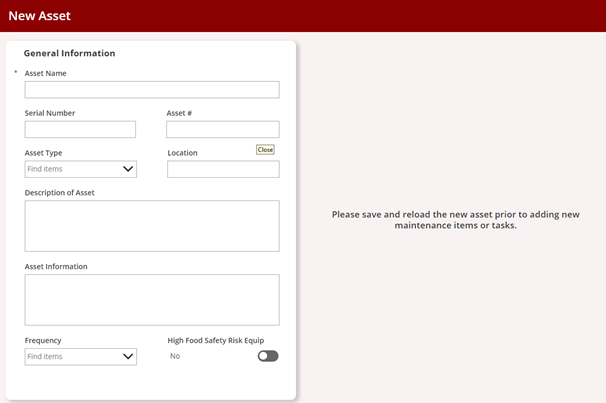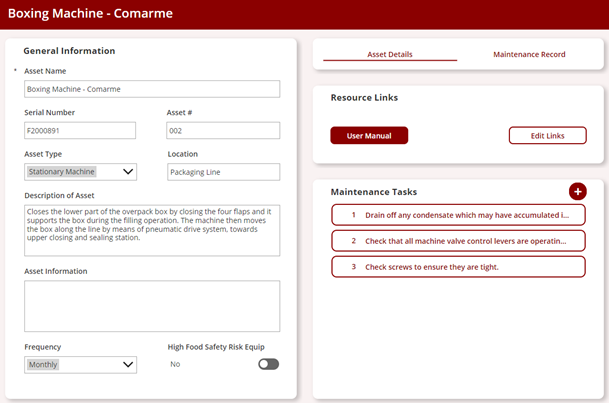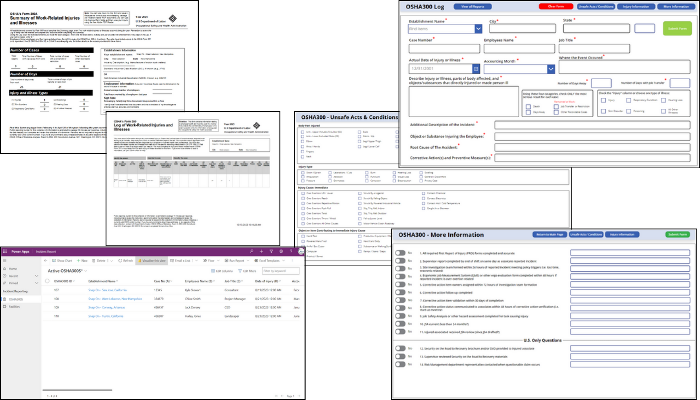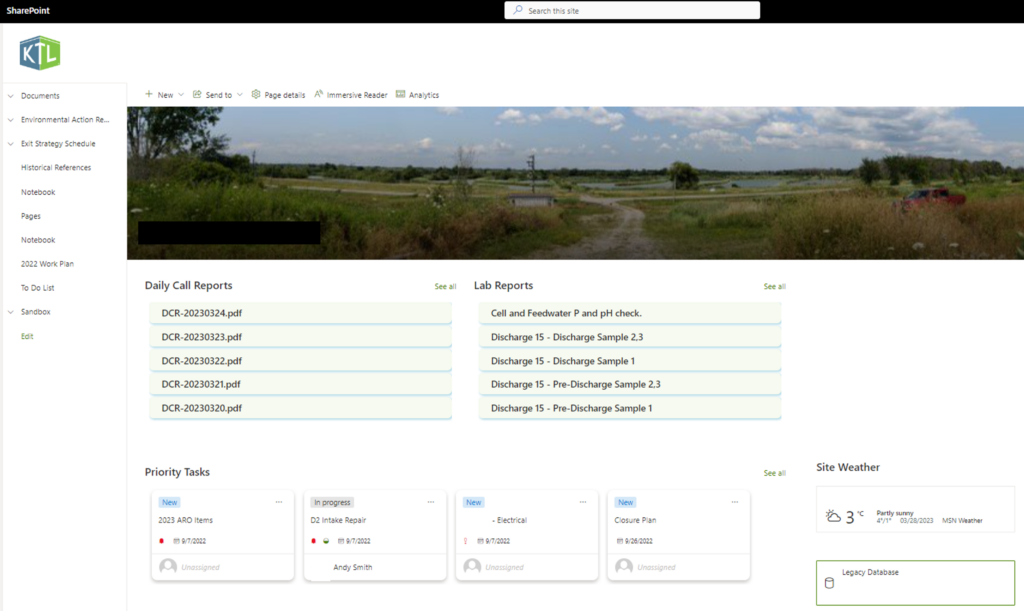
Tech Corner: Asset Management Tool
Functionality: What does it do?
Asset management tools are designed to track, monitor, and manage physical assets while ensuring adherence to regulatory standards and industry requirements. The tools centralize asset data, documentation, and asset-related compliance processes, while reducing the risk of non-compliance.
Benefits: Why do you need it?
- Compliance: Track compliance requirements and maintain auditable records.
- Documentation: Associate assets with manufacturers’ manuals and other required documentation.
- History: Record details of past maintenance and repairs.
- Location: Track the location of the asset and the department or users that it is assigned to.
- Maintenance: Track and schedule maintenance tasks.
- Properties: Maintain a fully customizable list of details about many different types of assets.
Technology Used
- SharePoint
- Power Apps
- Power Automate



Tech Corner: Vendor Management
Functionality: What does it do?
Vendor management is the process of coordinating vendors and suppliers. It includes activities such as selecting and approving suppliers, reviewing qualifications, negotiating contracts, ensuring quality, and compiling required documentation. KTL’s vendor management/supplier approval system provides a web-based tool to effectively approve and manage vendors and suppliers. It enables businesses to control costs, minimize potential risks related to vendors/suppliers, and meet regulatory requirements (e.g., Food Safety Modernization Action (FSMA) Foreign Supplier Verification Program (FSVP) Rule).
Benefits: Why do you need it?
KTL’s web-based supplier approval system:
- Provides a checklist to ensure all vendors and suppliers meet required criteria (e.g., certifications, licenses, performance history).
- Manages vendor and supplier-specific requirements.
- Stores and organizes supplier documents and records; suppliers can upload their own documents in a secure folder (if external user access is allowed).
- Enables facilities to conduct and manage vendor evaluations.
- Sends email notifications of supplier-related compliance deadlines.
Technology Used
- SharePoint
- Power Automate (for email notifications)


Tech Corner: OSHA 300 Log Management
Functionality: What does it do?
The Occupational Safety and Health (OSH) Act requires certain employers to prepare and maintain records of work-related injuries and illnesses. Employers must keep an OSHA 300 Log and OSHA 300A Summary for each establishment or site that documents specific details when an incident occurs. KTL’s OSHA 300 PowerApp is a comprehensive intake form tailored to OSHA 300 and OSHA 300A requirements that makes it easier to collect, search, and analyze data—and maintain OSHA compliance.
Benefits: Why do you need it?
KTL’s OSHA 300 PowerApp provides the following:
- Easier data entry. The app guides users through all required OSHA questions to help ensure no crucial data points are missed.
- Reduced errors. The intuitive design and in-built checks reduce the chances of errors, leading to more accurate reporting.
- Improved searchability. Microsoft Dataverse provides quick and efficient access to stored records. The digital format makes it easy to filter, search, and analyze records and data to offer deeper insights into safety performance.
- Mobility. The PowerApp can be accessed from any device, anytime, anywhere, making the reporting process more flexible.
- Data security. Log entries are stored safely, ensuring data integrity and security.
- Improved visualization. Incident data can be viewed in real-time as two paginated reports:
- OSHA 300 Log: Detailed record of work-related injuries and illnesses.
- OSHA 300A: Summary of the OSHA 300 Log, which can be displayed prominently at workplaces.
Technology Used
- PowerApps
- Microsoft Dataverse
- Power BI


Tech Corner: Customer Complaints Log
Functionality: What does it do?
Whether a company sells directly to consumers or to other manufacturers, managing, monitoring, responding to, and trending customer complaints is an important part of a risk management strategy. KTL’s customer complaints log provides a central location for companies to capture and respond to customer complaints—and then trend that data to ensure complaints are tracked to closure and any necessary changes are made to alleviate company risk.
Benefits: Why do you need it?
A web-based customer complaints log:
- Simplifies collection of customer complaint information via electronic forms.
- Aggregates all customer complaints in one central database to support the management and trending of customer complaint data.
- Documents, assigns, and tracks resolution of customer complaints.
- Establishes follow-up action requirements and associated deadlines to ensure any required changes are made.
- Helps manage the risks associated with customer complaints and potential recalls.
- Meets certification standard requirements for complaint management (e.g., Global Food Safety Initiative (GFSI)).
Technology Used
- Power Apps: Creates customized forms and applications for data capture and initial complaint logging.
- Power BI: Allows for advanced analytics, data visualization, and trending of customer complaint data.
- Power Automate: Automates the workflow, task assignments, reminders, and follow-up actions related to complaints.

Tech Corner: Training Tracking
Functionality: What does it do?
Training is a key component of maintaining ongoing compliance—whether with regulatory requirements, supply chain mandates, or internal policies. Having a system that records employee training is critical, especially to ensure policies, procedures, and work instructions are followed. KTL’s training tracking systems allow for the centralized implementation, management, tracking, scheduling, assignment, and analysis of organizational training efforts.
Benefits: Why do you need it?
A web-based training tracking system can help:
- Outline and document training requirements.
- Create training plans and workflows for scheduling training and assignments by job title and function.
- Ensure competency through online quizzes.
- Log and track training and certifications completed—including classes, required reading, online education, CEUs, and outside certifications.
- Track certification/training expirations and send notifications to complete training.
- Create individual dashboards and training reports for managers and employees, improving accessibility of training expectations and records.
- Demonstrate compliance with regulatory requirements for training.
Technology Used
- SharePoint to store the training data
- PowerApps to record and manage course information
- Power Automate for email notifications
Tech Corner: Permit Tracking
Functionality: What does it do?
Depending on the breadth and location(s) of a company’s operations, managing permits and their associated requirements and due dates without a centralized system in place can present significant challenges: How many permits does your operating system have–and what are the associated requirements? Who is responsible? Are there key/critical dates? How do you manage all that information and verify compliance? KTL’s permit tracking tool provides a central repository to track, manage, and communicate permit activity tracking.
Benefits: Why do you need it?
A web-based permit tracking system can help:
- Catalog and track permits and associated requirements and timeframes in one database.
- Manage change information.
- Store critical documents for easy access and effective record control.
- Send and receive notifications of permits about to expire.
- Coordinate and communicate with project contractors.
- Establish accountability and a standardized approach for reporting, monitoring, and performance measurement.
- Improve permit compliance assurance reliability, efficiency, and consistency.
Technology Used
- Microsoft Power Automate: send/receive notifications
- Canvas PowerApp: catalog permits, trigger notifications, create user interface
- SharePoint Lists: tracking changes, store data
- SharePoint Document Library: store attachments, permits, contracts, etc.

Tech Corner: Electronic Standards Register
Functionality: What does it do?
Certification standards are designed to ensure an organization’s customers, suppliers, and stakeholders that its products/services meet best practices. Each of these standards (e.g., ISO, GFSI, industry-specific) has a set of requirements that must be met to achieve certification. An electronic standards register organizes all of an organization’s standards requirements into an online tool, allowing for better management, tracking, and overall compliance.
Benefits: Why do you need it?
An electronic standards register:
- Assists with compliance demonstration and document control by allowing mapping of documents to specific certification standard requirements.
- Facilitates activities during remote or onsite audits.
- Ensures standard version support during future updates.
- Identifies common requirements and allows documentation to be linked between standards, as needed.
- Allows the internal audit team to complete and keep notes for the internal audit.
Technology Used
SharePoint

Tech Corner: CAPA Tracking Log
Functionality: What does it do?
Corrective and preventive actions (CAPAs) are those actions an organization takes to make improvements and/or eliminate causes of non-conformities. The CAPA Tracking Log records, assigns, and tracks CAPAs to closure. This is important, as failure to implement and close a CAPA may be considered a major non-conformance.
KTL’s CAPA Tracking Log also tracks recommendations to improve. Unlike CAPAs, recommendations do not correct a non-conformance; rather, they are suggestions to refine or improve processes.
Benefits: Why do you need it?
The CAPA Tracking Log provides the following:
- Records, assigns, and tracks CAPAs to closure.
- Assigns tasks to specific team members.
- Communicates due dates and sends notifications when tasks are overdue.
- Facilitates verification of completed activities and associated documentation.
- Prevents the occurrence and/or recurrence of issues.
- Optimizes processes and ensures that deliverables are free from defects and other non-conformities.
Technology Used
- SharePoint
- Power Automate

Tech Corner: Document Management
Functionality: What does it do?
A document/records management system creates a company-wide framework for central and secure storage and organization of and access to documents and records. Having a good document management system is essential for maintaining the vast number of documents required by regulations and standards, particularly since some have retention cycles for as long as 30 years.
Benefits: Why do you need it?
Document management provides the following:
- Central and secure storage, organization, and access to documents and records locally or remotely.
- Process and document standardization.
- Higher quality data due to reduced human error.
- Improved collaboration and dissemination of document updates to staff.
- Improved document searchability and accessibility.
- Enhanced workflows for approving and completing tasks involving documents.
- Easy access for audits and clear audit trail.
- Version control and history.
- Reduced paperwork.
- Ease in uploading documents (similar to a shared network drive) and adding/updating metadata for searchability.
- Improved security of sensitive documents (permissions that can be applied at the document level).
All of which lead to more consistent, efficient, and reliable compliance performance.
Technology Used
SharePoint

Tech Corner: Dashboards
Functionality: What does it do?
A dashboard is a tool used to quickly display and visualize data, typically using charts, tables, and other graphic elements. Dashboards provide a quick and simplified way for users to understand complex data sets, review key performance indicators (KPIs), and identify trends or patterns.
The data collected in most business processes—ranging from the outputs of an inspection form to the inputs into a companywide sales program—can be displayed in a dashboard. For example:
- Forklift Pre-Op Inspection Dashboard: A dashboard could be set up to track and visually display when the inspection form is being filled out, by whom, what types of issues are being identified, how frequently they are identified, and what outstanding issues need to be closed. These dashboards can help identify trends and improve overall management of the inspection program.
- Marketing and Sales Dashboard: Marketing and Sales departments rely heavily on metrics. Dashboards allow the end user to visualize data that is being tracked, such as advertising return on investment, engagement, growth, revenue, website traffic, sales pipeline, etc. These dashboards can help with sales forecasting and informing marketing decisions.
- Homepage Dashboard: Homepage dashboards are often used as internal landing pages that display important data related to the company and/or specific projects. These might be formatted to contain key metrics, important documents, sales data, assigned tasks, etc. They provide a quick, at-a-glance view of relevant data and information.
Benefits: Why do you need it?
- Dashboards provide an integrated view of data pulled from multiple sources into an easy-to-read display.
- Simplified data visualization allows for improved and more efficient decision-making.
- Dashboards metrics provide for real-time monitoring of data as it is being collected.
- The collaboration, customization, and transparency provided through dashboards help support organizational objectives.
Technology Used
- Excel
- Power Apps
- Power BI
- SharePoint

